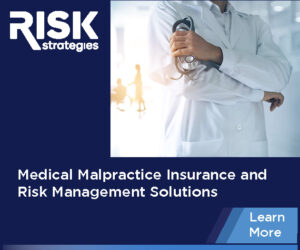By Jennifer Negley, Vice President, Risk Strategies Company
Thursday, October 21, 2021
Safeguard your business from the cyber criminals aiming straight at health care

Health care has been a favorite target of hackers for years. In fact, from 2015 to 2019, ransomware attacks accounted for 28% of all known healthcare breaches. Any size practice is at risk. For years, many malpractice carriers have included some type of complementary cyber liability coverage. But with the rapid shift in the types of threats we’re encountering, you need to beware of what your policy does not cover. It is always advisable to seek a stand-alone product, which in almost every case, provides more comprehensive coverage.
Ransomware Trends
Since 2018, ransomware incidents increased 150% with 70% of involving a data exfiltration threat and an average 21 days of downtime. Due to these troubling trends, carriers are leaving the market, curtailing coverage or non-renewing insureds. To help control costs while maintaining comprehensive coverage, Risk Strategies National Cyber Risk practice recently identified five critical measures to consider when navigating a challenging market.

Jennifer Negley
- Multi-factor Authentication: Historical data shows a direct correlation between cyber incidents and the lack of multi-factor authentication (MFA). All users in a company, regardless of their level of access, should have MFA, a sign-in method that requires users to confirm their identity through two or more separate mechanisms, such as facial recognition or verification code. This is especially important for remote and hybrid workforces. Without MFA, someone logging in with your credentials could gain access to email, company networks and key applications with sensitive data.
- Endpoint Detection and Monitoring: Endpoint detection security systems monitor data in real time to determine if there are any ongoing active threats. Automatic monitoring and alert-generation is a crucial security measure, and it works best if there is a security operations center staffed in-house or via a managed service provider to monitor alerts 24/7.
- Security Training: Making sure employees undergo security awareness training is essential. Having up-to-date enterprise technology is great, but your employees are your first line of defense. Specialty insurance brokers can be very helpful in finding vendors that provide security awareness and phishing testing, provide analysis on the results and implement a plan to improve when necessary.
- Backups: Not backing up your data makes a ransomware attack exponentially more difficult to recover from — and much more expensive. All organizations should have a carefully considered process in place to restore their network with minimal disruption. Backup systems also need to be frequently tested to determine efficacy.
- Regular System Patching: Software and hardware require regular patches to reinforce security vulnerabilities. Ransomware is always looking for the holes that patches are designed to fill. Make sure you’re staying current with your vendor’s latest updates and have a regular patching cadence with immediate action taken on high priority issues.
With the volatility of the current cyber market, having a specialty team available to walk you through products, services and best practices can make all the difference in securing the best policy terms.
For more information on insurance options, contact Jenn Negley at 267-251-2233 (cell) or jnegley@risk-strategies.com





